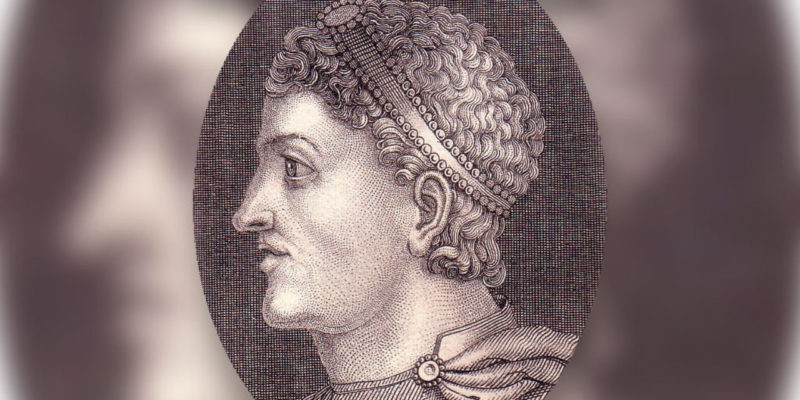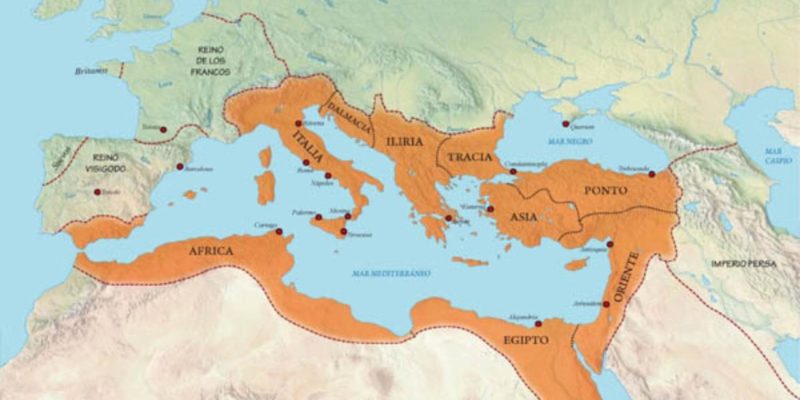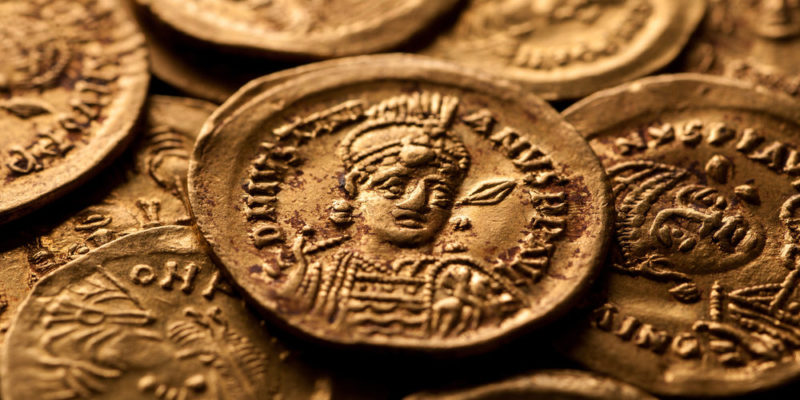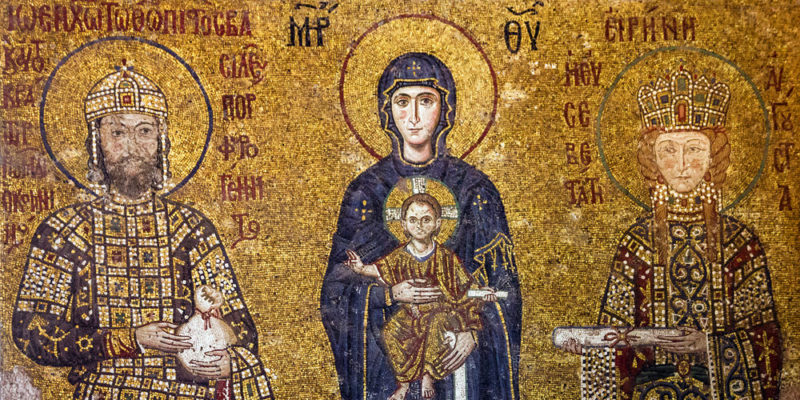We explain what the Byzantine empire was and what the history of this empire is like. In addition, the territories that it included and its characteristics.
What was the Byzantine Empire?
The Byzantine Empire, also known as the Eastern Roman Empire , was a division of the Roman Empire that survived through the Middle Ages and the Renaissance , located on the eastern shores of the Mediterranean Sea .
It can be defined as a multi- ethnic Christian state , with important cultural, economic and political influence in the world at the time , whose existence is due to the fall and division of the Roman Empire after the reign of Theodosius I, after his death in the year 395.
It distinguished itself from the Western Roman Empire , which would soon disappear , despite holding similar political and religious values that made it a barrier against the spread of Islam into Europe . The history of Byzantium is often interpreted as symbolic of the widening gulf between the Western and Eastern cultures of human civilization.
The Byzantine Empire lasted from 395 to 1261 AD and had ancient Byzantium as its capital, first baptized New Rome and then Constantinople, in honor of Emperor Constantine I. Today it is known as Istanbul.
Origin of the Byzantine Empire

The origin of the Byzantine Empire is traced to Emperor Diocletian's decision in the late 3rd century to administer the Holy Roman Empire more efficiently through two parts , each ruled by an Emperor Augustus, a Vice Emperor, and a future heir. .
This model remained alive until the death of Diocletian and then produced a series of internecine wars that Constantine I put an end to, unifying both halves of the Empire and declaring Byzantium as the new capital (“New Rome” was called, but it was known as popularly as Constantinopolis , the city of Constantine). At that time Christianity was also assumed as the official religion of the Empire.
Later, the death of Theodosius I in 395 divided the Empire again , when his two sons each inherited one half: Flavius Honorius the western half, with its capital in Rome; and Arcadio the Eastern half, with capital in Byzantium.
The western empire would meet its end in 476 . The Eastern one would extend for almost seven hundred more years.
Territories of the Byzantine Empire

Initially, the territories of the Byzantine Empire corresponded to those of Greece , Egypt, Turkey, Romania, the Balkans, Libya, Syria, Palestine, and Mesopotamia , which were the Eastern Roman provinces. However, under the reign of Emperor Justinian I (527-565) the empire would reach its maximum borders , also taking over Italy , southern Spain and the entire coastline of Mediterranean Africa .
However, these borders were shifting and unstable , and by the time of their fall in the 13th century, under the invasion of the Ottoman Empire , the territories of the Byzantine Empire were limited to Greece and Turkey.
Population of the Byzantine Empire
The population of the Empire was varied, reaching 34,000,000 inhabitants at its height , with an average density of 13.6 inhabitants per square kilometer. It is estimated, however, that in the following centuries the population decreased (due to wars, plagues and the loss of territory) to 18,000,000 (11th century) and 3,000,000 (13th century).
Name of the Byzantine Empire

The term "Byzantine Empire" was never used by any citizen of it during its more than a thousand years of existence. The inhabitants of the Empire preferred to call themselves "Romans", using the Greek term: romioi , equivalent to Christian Greeks with Roman citizenship.
Therefore, the name of the State was simply the Roman Empire ( Basel romanion ), despite being called the Greek Empire by the rest of the Western nations, due to their preference for the Greek language over Latin.
The name "Byzantine Empire" would be coined in the 16th century by the German scholar Hieronymus Wolf, and would become popular much later, in the 18th century, thanks to French authors such as Montesquieu.
Identity of the Byzantine Empire
The citizens of the Byzantine Empire always felt much more Greek , and in fact adopted the Hellenic tradition and the Greek language, without this going against their feeling Roman.
By the 7th century, in fact, a series of reforms in this sense had distinguished it quite a bit from the Western Roman Empire: the classic Latin title “ augustus ” was replaced by “ basileus ” (king, emperor) and the administrative language of the empire became to be officially Greek. They even took pride in their Hellenic ancestry, even though it predated Christianity, the official religion of the Empire.
This patriotism, reflected in its artistic and literary productions , however, did not prevent Byzantium from being the center of a multi-ethnic state , the center of multiple trade routes that made it the world capital of its time.
Justinian's reign
The height of the Byzantine Empire occurred during the reign of Justinian I , in the sixth century. The victory against the Persians on the eastern border of the Empire allowed Byzantium to undertake a campaign to recover the territories of the former Western Roman Empire that had already ended and was divided among various barbarian kingdoms. Thus, the Empire once again took possession of the Mediterranean coasts of North Africa, Italy and southern Spain.
During this time there was an unparalleled cultural splendor , the best example of which is the temple of Santa Sofía, erected in Byzantium as a symbol of the imperial rebirth . However, the war efforts took their toll and plunged the Empire into a century to come of economic crisis and plague, resulting in the death of a third of Constantinople's population.
Dark Age

The 6th and 7th centuries constitute times of crisis for the Eastern Roman Empire , besieged on multiple borders by diverse enemies: the Persians resumed their struggle in the east, the Bulgarians and Slavs did the same in the north, and Islam conquered in the Middle East the richest territories of the Empire: Syria, Palestine and Egypt.
The emperors succeeded each other on the throne without succeeding in reestablishing the imperial fortress , ceding the Tiber and almost all of Italy to the barbarian conquests, and even having to defend Constantinople from the siege of the Avars and the Slavs in 626.
As if that were not enough, internecine wars tore the empire apart , such as the revolt of the Iconoclasts between 726 and 843, and a series of theological transformations that would result in the Orthodox Christian Church.
Macedonian revival
This period was followed by a major revival of the Empire , ruled by a dynasty of Macedonian kings and characterized by growing discrepancies between Eastern and Western Christianity.
The climax of this was the mutual excommunication of Pope Nicholas I and the Patriarch of Constantinople Photius , in what is known as the Photian schism and which allowed the separation of the churches . The final break between the two would occur in 1054.
The decline of the Byzantine Empire

The decline of the Byzantine Empire occurs at the hands of the feudalization of its society , through land transfers to the aristocracy, and the pressure of two new and powerful enemies: the Christian kingdoms of Western Europe and the Seljuk Turks.
During this time the Third and Fourth Crusades took place , in the framework of which the Crusader Siege of Constantinople in 1204 occurred. The Empire would never recover from the three days of looting and devastation. His strength would dwindle forever.
End of the Byzantine Empire
The Byzantine Empire ceased to exist in the fifteenth century , mainly under siege by the Turkish troops of Osman I. The aid of the Western powers was conditional on the reunification of the Catholic and Orthodox churches, a condition that the Eastern ones did not accept. So many watched impassively as the Ottomans marched on Constantinople. The final fall was in 1453 after two months of siege.
The above content published at Collaborative Research Group is for informational and educational purposes only and has been developed by referring to reliable sources and recommendations from technology experts. We do not have any contact with official entities nor do we intend to replace the information that they emit.
She has pursued her studies in The United States, where she has graduated in Business and Economics and is currently finishing her Master studies in International Economics and Finance. Miss. Amputee is fluent in three languages: English, Spanish and Russian and has elementary knowledge of French and Italian. She love exploring how Collaborative Research Group can become the best tool to achieve the (necessary) educational change. .
Leave a reply
Your email address will not be published. Required fields are marked *Recent post

Sport: What Is It, Types, Risks, Features, Characteristics and Examples

Dogs: Emergence, Features, Characteristics, Feeding and Breeds

Story: Definition, Elements, Structure, Features and Characteristics

